The Latest News and Views about ANTINOUS the GAY GOD
Compiled and Updated
By
Hernestus, Priest of Antinous

AUGUST 26th 2009
The Latest News and Views about ANTINOUS the GAY GOD
Compiled and Updated
By
Hernestus, Priest of Antinous


The rugged northeast English/Scottish landscape is the backdrop for a Hollywood blockbuster telling the story of a Roman legion said to have disappeared near Hadrian's Wall.
Oscar-winning director Kevin Macdonald has announced that principal photography has started in Scotland and Hungary on his film version of The Eagle of the Ninth, the classic historical novel that has enchanted boys (and girls) around the world for 55 years, featuring a Roman soldier posted to serve on the wall.
The Rosemary Sutcliff novel was inspired by the disappearance of the Legio IX Hispana (Ninth Legion), said to have vanished after the soldiers marched north from Hadrian's Wall to battle Caledonian tribes in 117 AD.
Macdonald, a Scot whose films include Touching the Void and The Last King of Scotland, said he is delighted to be filming one of juvenile literature's best-loved novels: "It is a book that I absolutely loved as a child.
"It is a part of history that has never been seen on the big screen before and that is why it is so exciting."

Macdonald has signed ex-model and up-and-coming actor Channing Tatum (right) for the lead in what he calls a kind of "Scottish Western".
The story is set in the year 140 AD and follows a young Roman centurion called Marcus Aquila (Tatum) in his quest for the truth about the disappearance of his father's legion in northern Britain many years earlier.
He is accompanied by his trusty British personal manservant slave named Esca, played by Jamie Bell (below left) of Billy Elliot fame. Donald Sutherland will also make an appearance as Marcus' uncle Aquila.
Marcus and Esca set out across Hadrian's Wall into the uncharted highlands of Caledonia to confront its savage tribes, make peace with his fathers memory, and retrieve the lost legion's golden emblem, the Eagle of the Ninth.

Sutcliff wrote in the foreword to her famous book that her story was based on the disappearance of the Legio IX Hispana and the discovery of a wingless Roman eagle standard centuries later in the Scottish borderlands.
The disappearance of the legion is disputed by some historians because documents suggest it fought elsewhere in the Roman Empire after its supposed "demise" in Britannia. They also differ with Sutcliff's theory that the legion was comprised of Hispanic soldiers. More likely, say modern experts, the legion won a decisive battle in Hispania. Most authorities believe the Ninth Legion was annihilated some years later in the eastern part of the empire, not in Scotland.
But no one knows for sure, and the mystery surrounding the disappearance of the Ninth Legion has endured for 1,800 years. The book, published in 1954, sold more than one million copies and was made into an acclaimed BBC mini-series in the 1970s starring young Anthony Hopkins as Marcus.
The film project is backed by Duncan Kenworthy, the man behind Four Weddings and a Funeral. Anthony Dod Mantle, who won the Academy Award earlier this year for his cinematography of Slumdog Millionaire, is director of photography.
Also, 2009 Academy Award winner Michael O'Connor and Academy Award nominee Michael Carlin (both for The Duchess) are the film's costume and production designers, respectively. Justine Wright will edit the film, marking her fifth consecutive feature collaboration with Macdonald.
The new movie rides the crest of a wave of high-profile Roman-themed hits, including Russell Crowe's film Gladiator and HBO/BBC drama mini-series Rome.

The sun has risen over our brothers in Australia and India (yes, we have group members in India). The LEO NEW MOON is working its leonine magic. It is the dawning of the 21st of August and the sun is leaving its conjunction with ANTINOUS THE MOON GOD and is taking its leave of the Sign of Leo.
All around the world worshipers of Antinous will begin commemorations of The Sacred Lion Hunt which climax on Saturday evening with solemn rituals at the Hollywood Temple of Antinous.
Picture it: Egypt, somewhere in the rocky wilderness between the scattered oases south of Alexandria. August of the Year 130. The Sun is exiting the Sign of Leo. The Constellation of Aquila the Eagle is at its zenith in the nighttime sky.
It is the constellation of the Emperor. And the Emperor and his Beloved are touring Egypt when they hear grisly accounts of a man-eating lion marauding the countryside on the edge of the cultivated land. The "Marousian Lion" it was called.
They lead a hunting expedition out into the wilderness. The whole expedition is rife with symbolism from the start since the Sun is in Leo in the daytime skies and the Eagle is soaring in the nighttime skies and the Ancients believed killing lions was tantamount to defeating death itself. Lion hunting was the sport of kings.
When at last the Imperial party flushes out the man-eater, the huntsmen and archers stand back and leave Hadrian to close in on the beast with his steed. Hadrian has just got off an arrow which wounds the animal when, all of a sudden, out of nowhere, young Antinous rides ahead, his reins in his left hand, an adamantine-tipped lance in his upraised right hand.
As the Imperial retinue looks on in horror, the snarling lion charges toward the boy, causing his panicked horse to whinny and wheel about in terror. But Antinous maintains his balance and, instantly judging distance and angle, sends his lance sailing towards the lion as it quickly closed the gap between them.

The lance slams into its rear flank, inflicting a serious but not fatal wound. Enraged even more, the lion uses its fangs to pull out the lance and charges anew against the Boy who is fumbling with his quiver to ready a shot with his bow. But an arrow is already in the air from behind Antinous, and it whizzes past his ear and hit its mark in the throat of the lion.
It has been fired by Hadrian, who is approaching at full gallop and who, even while the first arrow was still in the air, had already readied a second arrow, which this time penetrates both lungs.
The lion spins about and collapses writhing in the dust, rage in its eyes, blood and saliva guttering from its fanged mouth, gasping for breath as it struggles to get to its feet because Antinous has dismounted and is sprinting toward it with a drawn dagger.
Hadrian draws his steed to a halt and dismounts with an agility and lightness befitting a man half his age, fueled by adrenalin and alarm for his Beloved Boy, who faces imminent peril from the mortally wounded lion, still capable of severing an artery with one swipe of its mighty paw.
Hadrian draws his hunting axe from his belt and holds it high as he lunges onto the lion's back and dispatches the beast with one powerful blow which splits its skull in two with a frightening crack and a spurt of bright red blood which bathes both the older man, now panting and perspiring heavily, and the younger man who still shows no visible expression of concern, just a wild-eyed look of excitement in his eyes, as if he never realized the danger he had been in as if he thinks he is immortal.

A cheer goes up from the coterie of onlookers when they realize the lion is dead, killed seemingly by a single blow from the Emperor's hand. Courtiers whose eyes are unskilled in the ways of hunting will later claim Hadrian had struck the lion dead with a club.
As soldiers and nervous bodyguards rush forward to make sure everything is all right, the emperor, his adrenalin-strength ebbing as quickly as it came, shakily wraps a blood-spattered arm around Antinous and plants his gilded, spike-soled sandal on the dead animal's neck and nods to Antinous to do the same.
There they stand, bathed in blood and bathed in the adulation of the Imperial coterie, each with one foot on the vanquished man-eater as the animal's blood spreads out and covers the surrounding rocks and sand and a few scrubby wildflowers growing from a crevice in a rock.
Even the flowers are splattered with blood. And these red blossoms will be plucked by members of the entourage to take back as souvenirs to show to envious courtiers who had not been invited along.

THE SACRED LION HUNT was immortalized in poetry and in stone, with Hadrian adding medallions to the Arch of Constantine showing him and Antinous with feet on the lion's neck and also making sacrifice to the great lion-killer Hercules.
Soon legend would have it that scarlet-red lotus blossoms had sprung forth from the pool of the lion's blood, the lion which had been brought down by Antinous and which had been dealt its death blow by Hadrian the SACRED RED LOTUS.

Under the Sign of Leo. And under the Constellation of the Eagle.
Within a few short weeks, Antinous himself would be dead. The Sacred Lion Hunt is the last recorded event in His short life.
And some time afterward, grieving Hadrian would look up into the nighttime skies with tear-filled eyes and his court astronomers would point out a New Star which had appeared in the southern part of the Constellation of Aquila the Eagle.
The New Star would be interpreted as a celestial sign that Antinous had been raised to the firmament, that the Constellation of the Imperial Eagle had been joined by the CONSTELLATION OF ANTINOUS. It was a sign that Antinous was now a God.
If you go outside tonight and peer out into the darkness with all its deep and hidden dangers, remember Antinous and how he peered out into the barren wilderness with all its deep and hidden dangers. He charged forth, his bridle-reins in his left hand and an adamantine-tipped lance in his right, and he faced death unafraid.
For Antinous knew he was immortal.
The Constellation of Antinous, still under the wing of the Imperial Eagle, will be right directly over your head tonight shining proof that Antinous is a God and that he is indeed immortal.
Don't look out into the darkness around you and be afraid. Instead, look up and remember the Beloved Boy, who was a fearless hunter, who stalked death itself, and who emerged victorious over it.
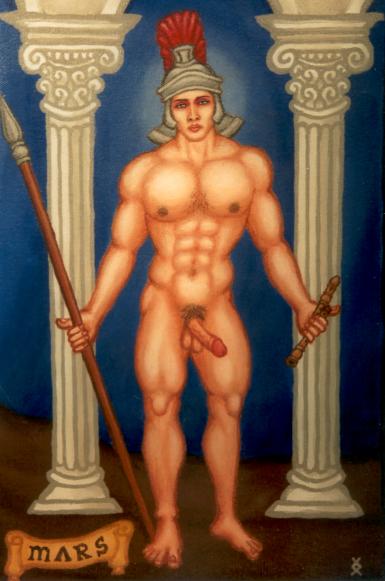
On August 20th the Religion of Antinous commemorates the Sacred Band of Thebes, the Army of Gay Lovers whose courage and valour have echoed down through the ages as an inspiration that Gay Love is a magical means of Conquering Fear and Doubt.
The Sacred Band of Thebes, also called The Theban Band, was a battalion composed entirely of homosexual friends and lovers. This military unit, consisting of 150 male couples, was based on the belief that men fighting alongside their lovers would die rather than shame one another.
According to Aristotle, the Army of Lovers were sworn into military service at the Tomb of Iolaus, one of the many male lovers of Hercules. Iolaus had helped the god in the Twelve Herculean Tasks.
He often acted as Hercules' charioteer and companion, and the closeness of their relationship was such that he was known as Heracles' symbomos (altar-sharer), since the two could be honored at one and the same altar a very rare occurrence in ancient Greece, where each divinity would have his or her own altar.
Iolaus was called the eromenos (beloved boy) of Hercules, and was thus a Sacred Hero of same-sex love in Thebes. Hercules, Iolaus and Eros were often depicted together.
That is probably why the army of gay lovers was called the Sacred Band, since they took their oath of allegiance at the Sacred Tomb of Iolaus, which was at the same time a shared sacred altar to Hercules. In effect, the warriors were swearing that they would fight alongside their comrades the same way Iolaus and Hercules fought together armed with the arrows of Eros.
You can see the parallels to Hadrian and his beloved boy Antinous, and later this week the parallels become even clearer when we commemorate the SACRED LION HUNT. After that hunt in the Libyan desert in the summer of the year 130 AD, Hadrian and Antinous made sacrifice to the Great Lion Slayer Hercules thus cementing the identification between Hadrian/Hercules and Antinous/Iolaus and their affiliation with the Sacred Band of Thebes.
The great Theban general and tactician Epaminondas is generally credited with establishing The Sacred Band, although some sources claim it was his "beloved friend" Pelopidas who was responsible for recruiting them. No matter they both fought side-by-side at the head of The Sacred Band.
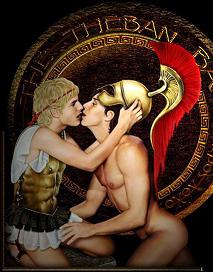
This corps d'elite first took to the battlefield against Sparta, which had dominated Greece since the fall of Athens in 404 BC. The Spartans were confident of victory, as they had never suffered a defeat on the battlefield never ever.
Deploying the Sacred Band on his front left wing, "Epaminondas made his left wing fifty deep and flung it forward in the attack." The "extra weight" of this wing and the "fanatical bravery of the Sacred Band" broke the Sparta right wing, which contained their best warriors. In the ensuing hand-to-hand combat, the Spartan king was killed and their right gave way.
Witnessing this, the rest of the Spartan forces, who had not yet been engaged, fell back in disarray, running for their lives. Thus, Sparta suffered their first recorded defeat in more than 400 years at the hands of an Army of Gay Lovers.
But the end came in 338 BC at the battle of Chaeronea when King Phillip II of Macedonia and his son Alexander (later called Alexander the Great) defeated the combined forces of Athens and Thebes-Boetia. Alexander confronted The Sacred Band of Thebes, the elite corps of 300 homosexual lovers who were by that time the most respected soldiers in the world.
But alas! They were no match for the Macedonians under Phillip and Alexander. It was a rout. The Athenian and Theban armies gave way and began retreating from the advancing Macedonians. Only The Sacred Band stood their ground and died. Only a few were subdued and captured. Of those who died, it was found that not one had been wounded in the back a sign that they had not turned away from the fight.
Alexander was so moved by their nobility and courage that he asked his father to bury them with honour and raise a monument in the form of a Sacred Lion over their mass grave. In 1881, the shattered fragments of this Lion Tomb were discovered, surrounded by the bones of 254 pairs of men with their weapons, arranged in a phalanx of seven rows, the battle formation of the Sacred Band.

In 1902 the fragments of the Sacred Lion were reconstructed and placed again over the tomb of The Sacred Band (depicted left) by the secret homosexual society known as the Order of Chaeronea, founded by gay-rights pioneer George Cecil Ives.
It reminds us once again of the Sacred Lion Hunt which we celebrate later this week.
So, what has all of this got to do with us in our daily lives? We're not soldiers. We're not brave and courageous. Like Dorothy Gale, we're meek and mild. Timid. We know that if we were on a battlefield, we would turn and run. We would hide and "play dead" and hope nobody found us.
We assume that the Army of Gay Lovers were all fearless. We think they were unafraid. We don't think of them as being saredy-cats like us. We think they didn't mind the prospect of agonizing death. We think they were somehow above such mortal fears and doubts.
That's nonsense, of course. They were scared shitless. We can scarcely imagine how afraid they were. As they stood there alone against the mightiest army in the Ancient World, their emotions shifted beyond the mere terror of possibly being killed, to the actual horror of inescapable agony and death. It is one thing to be terrified we all know the fears generated by terrorists who fly airliners into buildings.
But the emotions experienced by those trapped in the planes or inside the burning buildings go far beyond mere terror to the actual horror of inescapable agony and death. That is the Mystery of Terror as opposed to the Mystery of Horror. We tend to forget the distinction!
The Army of Gay Lovers were not without fear. On the contrary, they were staring into the horror of impending pain and death. But they did not allow their fear to overwhelm them. Instead, they turned their fear "inside-out" and used it as a magical shield. The barbs of fear were no longer poking inward to themselves, but instead were pointing outward towards their foes.
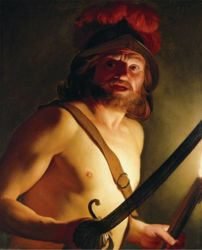
And that is the Mystery Teaching of the Army of Gay Lovers. It was no doubt part of the initiation which the recruits underwent at the Tomb of Iolaus. They were schooled in magico-religious methods for handling fear. It's about learning to harness Mars energy. Mars is all about the double-edge sword of fear/bravery and how you can learn to wield that Sword of Mars.
It's not about being fearless. It's about being able to transform your fear into a mighty force which wins the battle of life. Mars Warrior Energy is not about death. It is about LIFE. It is about harnessing fear and doubt and turning them into useful energies in your daily life.
By the way, 2009 astrologically is the YEAR OF MARS. But when you think about it, this year is not so special. That's what life is all about. Life from the time you are born until the time you die life is just one constant battle. And if you give in, then you are lost. And if you give in to the fear and doubt that constantly confront you each and ever day, then you are lost. It's about transforming fear and doubt into constructive energies which empower you to stand up and wade into the fray of daily life.
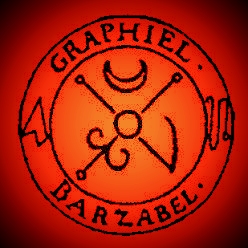
The Band of Thebes were initiated into Mystery Teachings which showed them how to transform fear and doubt into a magical force which made them invincible capable of asserting their will and making their dreams become reality. And the catalyst was male-male love and devotion.
This is one of the deepest and most profound Mystery Teachings of the Religion of Antinous. We are talking about the Mysteries of Antinous-Mars. This is why Arch Priest Antonyus Subia has painted Antinous in the guise of the War God (above left). Antinous is not just about gay male beauty. He is about gay male warrior energy.
Mars is a very important constituent aspect of Antinous. In Fixed Star Astrology, the STAR OF ANTINOUS is characterized by a mixture of Jupiter/Mars energy along with Venus energy unique among Fixed Stars. To overlook Mars is to overlook a major component of what Antinous is all about.
Mars and his Alchemical Intelligence Graphiel and Daimon Barzabel (Deimos and Phobos) is much misunderstood by philosophers and occultists. The fiery Graphiel/Barzabel energies of the red planet ("terror" Deimos and "horror" Phobos) are often seen as frightful and horrific and destructive and warlike with no other qualities. This is a shallow analysis and one that should be discarded. Understanding your Martial nature the Antinous-Mars warrior inside you is essential to your survival and growth as a gay man. Terror and horror accompany us all our lives.

We are all afraid every day. We are all riddled with doubts every day. Look around you most people are consumed with fear and doubt. Fear fuels their lives! But each of us can learn to turn our fears and doubts "inside-out" so that their barbs no longer point inward towards us, but instead so that these barbs of fear and doubt form a protective shield around us. It girds us with a constructive energy which helps us to advance through the Herculean travails which we face in our daily lives. Instead of being "fearfully" timid, we become "fearsomely" determined not to let life get us down.
Later this week, this transformational ability to turn fear "inside-out" will help us to understand how Antinous was able to charge the man-eater during the SACRED LION HUNT.
He must have been terrified. He was young and inexperienced and alone on his steed and armed only with an adamantine-tipped lance.
But through his loving bond with Hadrian/Hercules, Antinous/Iolaus was also magically armed with the "fearsomely strong" energies of the Sacred Band of Thebes.
Arch Priest Antonyus affirms: "We consecrate and honor their memory and call upon their strength and courage in our own hearts, that we may become the New Sacred Band."
On the 13th of August the Religion of Antinous celebrates the Birth of Diana, the Divine Huntress, who was born on this day, according to the Lanuvium inscription which is consecrated to Antinous and Diana.
Traditionally, she is said to be the twin sister of Apollo. But in the Religion of Antinous, our belief is that the virgin huntress is the female Antinous, his twin sister, goddess of lesbian beauty just as Antinous is the god of gay beauty.
Diana and Antinous are deities of the Moon and, because Antinous is often also assimilated to Apollo, he therefore substitutes as the twin of Diana, though he can often be viewed as her male double ... so that Antinous is Diana.
The most splendid and most inspirational sculpture representing this Diana/Apollo/Antinous relationship is located in Sydney, Australia. Right in the middle of this bustling city there is a huge green space called Hyde Park.
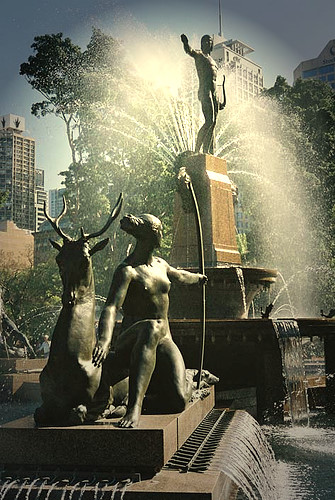
Skyscrapers form canyons on all sides of the park, which is shady and leafy-green all-year-round thanks to the eucalyptus gum trees, which never lose their leaves in winter.
The Hyde Park gum trees are enormous and form a canopy over the park, filtering out the sounds of car horns and sirens and jetliners passing over head.
Hyde Park is a magical place. And right in the middle of Hyde Park there is a clearing where a philanthropist back in the 1920s commissioned an exquisite Art Deco fountain, the Archibald Fountain named in the benefactor's honor, which features Apollo, Diana, Pan and other figures.
Diana and her faithful hunting dogs are looking towards her solar twin Antinous/Apollo, who stretches his hand out to her in greeting as rays of sunlight spray out in all directions.
The "rays" are of course water. But when you walk under the dark canopy of the towering gum trees toward the clearing, you can't help but see the solar symbolism.
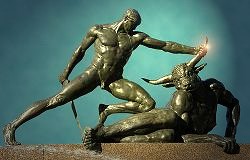
Theseus and the Minotaur are also depicted under the shower of rays from Antinous/Apollo. It's a bit hard to tell whether Theseus and the Minotaur or engaged in a life-or-death struggle or whether they are just about to have some really hot sex.
Most tourists are so busy taking photos of these sculptures (Diana/Apollo/Theseus) that they overlook the fourth sculpture, which is Antinous/Pan caressing a goat and a ram.
The plaque avoids any names, only saying the figure represents "the young god of the fields and pastures, of the pleasure of the countryside" but it is clear that the French sculptor (a life-long bachelor) drew on Antinoian imagery.
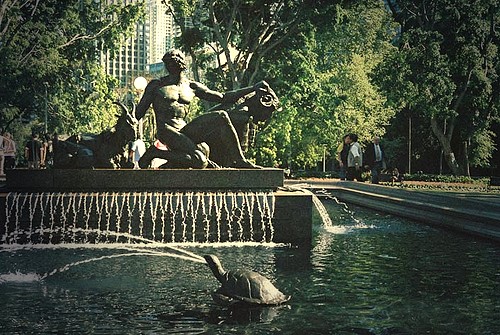
Taken altogether, they form a single symbolic Antinous Mystery Teaching.
Possibly the most extraordinary thing about this magical fountain is the fact that, as you sit there in front of it (getting wet as the breeze blows the "rays" into your face), you are accosted by Sacred Ibis birds which congregate at the fountain in search of handouts from office workers on their lunch breaks.
It is a zoological mystery as to how Nile Sacred Ibis birds ever got to Australia, but they were already there when Captain Cook arrived in the 18th Century. And they flock to the Diana fountain to cadge food from photo-snapping tourists and sandwich-bearing secretaries.
But be careful, for they are very crafty birds. Give one ibis a crumb, and instantly you are surrounded by dozens more. The Nile Sacred Ibis is, after all, the Hermetic Sacred Bird of Learning.
The Nile ibis is of course the Sacred Animal of Hermes/Thoth. And it was across the river from the Sacred City of Hermopolis and the Temple of Hermes/Thoth where Antinous plunged into the Nile.
This lovely Diana fountain for many years was the cruisiest place in Sydney. The public toilet right next to the fountain was the most notorious "Tea Room" in the Antipodes for many years until it was converted into a chic bistro in the '90s. Oldtimers in Sydney still recall that this fountain was the only example of nude male sculpture in a public space in Sydney for many, many years.
It is one of the few places in the world where you can sit in the presence of Antinous in several of his many forms Diana/Apollo/ Pan and even (on a very arcane and esoteric level) Theseus the Bullfighter. The STAR OF ANTINOUS is sometimes associated with the Fifth Tarot Trump, which is assigned to Taurus the Bull and is about the striving to achieve harmony between earthly and spiritual yearnings. We are all bullfighters.
And we are all hunters. And we are all the prey which is hunted by Diana/Antinous. We search and hunt for Antinous but it is Antinous who catches us. We are fooled by his guises and his many names. We are dazzled by his beauty just as a fish is dazzled by an angler's shiny fly bait. We are the hunters and yet we are the prey, and Antinous seems to say to us:
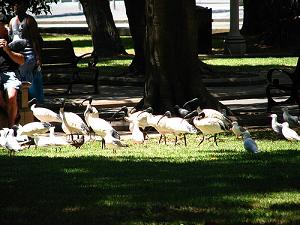
"Gay men think they seek me, But it is I who seek them, No other seeker is there than myself, And when I find mine own, The pain of questioning is at an end. The fish graspeth the hook, Thinking to find food, But the fisherman is the enjoyer of the meal."
Similarly, the Huntress Diana is also hunting us. Arch Priest Antonyus Subia explains it this way:
"She is Helen of Troy to the Castor and Pollux of Antinous-Apollo. They share not only the attribute of hunters, and of the moon, but also as gods of magic and darkness. Diana is often compared to Hecate, the supreme goddess of Theurgian magicians, who rose to prominence during the reign of Marcus Aurelius. Antinous therefore is the male equivalent of Hecate.
We pray to Diana to guide us in our hunt and to illuminate our nights with the silver light of her sublime power. We recognize that the Moon of Diana is the Moon of Antinous. On this night we venerate the Virgin, she who guides new life into the world, goddess of beasts, the mistress of the hounds, the archeress, the young Great Mother of Ephesus."
Diana is the twin of Antinous. Antinous is Pan. Antinous is Apollo. Antinous is the Bullfighter. And yet Antinous is none of these deities. He is all of them. And he is none of them. The OBELISK OF ANTINOUS says he can assume any form his heart desires because the "Semen of the First God" truly is in his body. Thus he is beyond all forms. Even as he creates all forms. Outside of Time and Space. And yet, within our hearts.
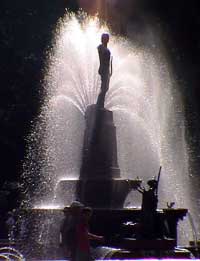

In these days of economic uncertainty, we all know the anguish of waiting to hear whether we will soon lose our homes and livelihoods. But few of us have to worry about being murdered by rivals. Hadrian spent years in exactly this sort of anguish.
On August 11th, the Religion of Antinous commemorates the accession of Hadrian to the throne as Emperor of Rome, succeeding Trajan.
Hadrian had to wait many years in a very deadly sort of legalistic limbo before he became emperor. Trajan was in no hurry to name him officially as his heir, fearing Hadrian might then bump him off. While they shared many affections and even shared some young men they shared little trust in each other.
And so Hadrian was left waiting and wondering and worrying year after year. Wondering when or if he would become Emperor. Worrying what would happen if Trajan were to die suddenly and some rival contender became Emperor and perhaps murdered Hadrian.
We all know this sort of worry-and-wait situation, albeit on a less history-changing scale. We apply for a job, or we await a loan approval or we await a buyer's final offer on the house and there is nothing we can do but worry and wait. Hadrian sought out soothsayers, astrologers and magicians to assuage his fears.
Hadrian had been on tenterhooks for years wondering whether Trajan would formally adopt him as his heir. If Trajan died without the issue of succession being settled, it could result in civil war or at least in the assassination of Hadrian by some other ambitious man.
Our own Arch Priest Antonyus Subia explains what happened next and what this meant for succeeding generations of gay men everywhere:
"Then finally, while on campaign in Nikomedia, capital of Bithynia, Hadrian receives word that Trajan unexpectedly died on August 8th. He learns that Trajan's 'deathbed will' named him as the emperor's adopted son and successor. It is believed that the Empress Plotina forged the will of her husband, naming Hadrian as successor. "Whatever happened, the Legions proclaimed Hadrian emperor on August 11th. The support of the army assured the validity of our Emperor's claim, ushering in the Sacred and Golden Age of the Antonines, the last dynasty of peaceful and wise emperors before Rome's inexorable decline and fall. "Hadrian became Emperor over Rome at the pinnacle of her glory. Her boundaries stretched farther than ever before; farther than they ever would again. Millions of people were subject to his authority. As Emperor, Hadrian first made peace with the Parthians, surrendering some of the land that Trajan had occupied, and then began the work of consolidating the Empire from the inside. "We celebrate the Accession of Hadrian as the miracle that might never have been, without which Antinous would never have been known, and our religion would never have been born. Hadrian is Our Father, Our Emperor and Our Capitoline God, we recognize on this day that the beginning of his age is the beginning of our own."
On Tuesday, please take a moment perhaps at your office desk altar to remember the day on which Hadrian's long and heartfelt dreams and ambitions became reality and the path was paved for him to begin work on creating a civilization based on Hellenistic tolerance and above-all his dream of founding the perfect religion based on love and beauty.
May the Divine Hadrian help us all achieve our heartfelt dreams and ambitions in this regard.
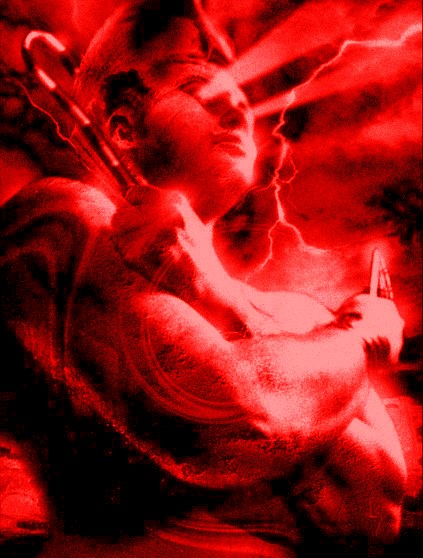
Antinous entered Alexandria on August 1st of the Year 130, ushering in the climactic final weeks of His brief life. Alexandrians turned out, of course, to see Emperor Hadrian and his splendid entourage. But as no emperor had ever had such a high-profile boyfriend before, EVERYONE wanted a glimpse of the fabled Antinous, "the emperor's favorite".
Famously infamous, Antinous arrived in the great city like the Egypto-Greco-Roman god Hermes-Anubis (Hermanubis, right). Antinous and Hermanubis were worshiped alongside one another in the Sacred City of Antinoopolis. Suitable for this God of Anubic Dark Light, the arrival of Antinous was received with decidedly mixed emotions in Alexandria.
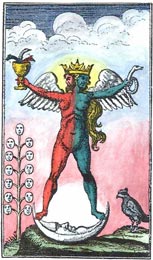
Alexandria was a teeming city of many cultures and rival factions. Christians and Jews waged bloody street battles, and the snooty Greco-Egyptian social elite looked down on the upstart Romans, gossiping viciously behind their backs, albeit in stage whispers.
Within a few short weeks Antinous would be dead. And shortly after that, He would be a God.
But on August 1st all of that was undreamt-of, and the Imperial entourage arrived in the blistering heat after crossing the Sinai Desert and receiving something of a lacklustre welcome from Egyptians in the Nile Delta.
In the midst of a great drought, the Egyptians were starving. And that meant that the Empire was starving, since Egypt was the breadbasket of the Empire.
The Egyptians were looking to Hadrian as their pharaoh and a living god to provide them with a miracle. Thus, Hadrian and Antinous arrived in Alexandria amidst political and religious strife and under tremendous pressure for decisive action on the drought crisis.
I have been trying to think of something inspiring to say on this occasion. But it has already been said far more eloquently by Arch Priest Antonyus Subia:
"The Imperial entourage entered Alexandria in the year 130, beginning the third year of the Peregrination. The people of the largest city in the Empire greeted Hadrian as Pharaoh and God in public celebrations. The Jewish and Christian community, as in Antioch, was not welcoming, being openly scornful of the divine honors lavished upon a man whom they considered immoral, due to the presence of Antinous.
"Alexandria was a city of diverse religious expression, it was also the home of the Museum and the restored library where Philosophers met to study, discuss, and debate the wide rage of philosophy. This difficult period spent in Alexandria is reverenced as the period in which the Gnostic Fathers came in contact with the ruler who had given them the freedom to resist Orthodoxy and set in motion their revolutionary doctrines, which would one day undo Christianity.
"The anxiety of the recent stay in Jerusalem was alleviated in the Hellenic-Ptolemaic Alexandria, a city of admixture, wisdom and magic. The god of Alexandria is Serapis, who is a fusion of Zeus, Hades, Helios and Dionysus, with Osiris and the Apis Bull.
"The name of the Alexandrian god is from the Egyptian Osar-hapis. Hadrian was so moved by the religion of Serapis that he modeled the structures of the Villa known as the Canopus after the Temple of Serapis, which are believed to be an allegory of the Nile, Antinoopolis and the deification of Antinous.
"The god Serapis is the guardian of the freedom and expression of Alexandria, the devotion to knowledge, secret and scientific, which the library held. Serapis prepares Antinous for his journey up the Nile and cleanses the newly forming god of the taint of condemnation heaped upon him by the Jews and Christians.
"As the sacred Star of Antinous nears its zenith in the night sky, Serapis unites Antinous with the immortal spirit of Alexander the God and his devoted Hepheistion."

The Dark Star in the Constellation of Antinous does indeed reach its zenith of the nighttime skies in August and is visible from any populated part of our planet just below the bright star Altair in the Constellation of the Eagle or just above Altair for those of you in the Southern Hemisphere.
The Constellation of Antinous is at its zenith in August before shifting slowly to the western skies in September to finally merge into the sunset in late October corresponding with the Death of Antinous.
Don't despair if you can't find the Star of Antinous. Don't worry if you cannot see any stars at all because you live in a large city.
The Star of Antinous is not something you see with your physical eyes. Just look up and REMEMBER Antinous. Remember the Bithynian Boy who arrived in Alexandria in August all those centuries ago.
Within a few weeks He would be dead. Shortly thereafter He would become a God.
The following July/August, the Nile Inundation would be bountiful for the first time in years the first recorded miracle of the Blessed Boy.
His renown would spread and he would gain a reputation as a God of Love and Beauty and Healing Magic.
The OBELISK OF ANTINOUS offers testimony to what happened after Antinous died. The hieroglyphs on the Obelisk of Antinous tell it all:
The God Osiris-Antinous, one of the Shining Ones in Heaven, has been transfigured into an eternally young god, perfect of face, whose beauty dazzles the eyes, whose heart is full of heroic joy since receiving the summons of the Gods at the hour of his death to join them.Every ritual of the Book of the Hours (Egyptian Mystery Teachings) will be performed for him along with each of His Mystery Rites. His Word will be disseminated throughout the lands of the Earth and His Word will be an unending source of advice, inspiration and mystery. Nothing like this has ever been conferred on any mortal man before now. And the same applies to His altars, His temples and His consecrated images, by virtue of the fact that He breathes the Breath of Eternal Life and His stature grows in the hearts of men.
He is able to venture forth anywhere he wishes. The Keepers of the Gates of the Duat (Underworld) say to Him: "Praise Ye!" They unbolt and fling open their Gates before Him every day for millions of millions of years. His lifespan is without end.
Offerings are brought daily upon His altars. He is honored in particular by the artists of Thoth in accordance with His glory.
He strides forth from His tomb to His many temples throughout the lands of the Earth and He hears the prayers of each man who calls upon Him and He cures the illnesses of the afflicted by sending them visions of healing. And when He has accomplished His work among the living, He assumes any form His heart desires because the Semen of the First God truly is in His being.
All Gods and Goddesses give Him the Breath of Eternal Life that He might breathe as One Who Is Eternally Young!
It all started with His arrival in Alexandria. Within a few short weeks He would be dead. Shortly thereafter He would become a god. His priests would be devoted to advancing the Antinoian Mystery Teachings, which centered upon one single, absolute and solely Great Mystery HOMOTHEOSIS finding the divine within ourselves as gay men. That is the Great Mystery of Antinous and it is the Spiritual Gift which He holds forth for each of us to grasp. Like Antinous, each of us can become divine. We do not need to die physically to achieve this boon. Our physical bodies do not need to be immersed until we perish, as did Antinous in the Nile. All we need to do is to plunge into the spiritual depths of His Mystery Teachings. Remember His arrival in glorious Alexandria. Remember Him!

On July 25th the Religion of Antinous joyfully commemorates the First Miracle of Antinous the Bountiful Inundation of the Nile which ended a drought which had caused food shortages throughout the Empire.
The famine had overshadowed the tour of Egypt by the Imperial entourage in the year 130. The half-starved Egyptians looked to Hadrian, whom they worshipped as pharaoh, to perform a miracle which would end their misery.
But as Hadrian and Antinous traveled up the Nile during the summer and autumn of 130, the Nile once again failed to rise sufficiently to water the fields of Egypt Rome's "Bread Basket" and chief source of grain and other staple foodstuffs.
It was a humiliating disappointment for the Emperor following the jubilant welcome by peoples during the earlier part of his tour through the Eastern Empire. In Ephesus and other cities he had been welcomed as a living god.
But the Egyptians had given him and his coterie what little they had in the way of food and wine and he had failed to convince the Inundation Deity Hapi to bless them with bounty. Hapi is one of the most extraordinary deities in the history of religion.
Hapi is special to us especially because Hapi is hermaphroditic. With many other such deities, the gender division is down the middle of the body (like some Hindu deities) or the top half is one gender and the bottom half is the other.
But Hapi is very complex and the genders are mixed throughout his/her body. Male deities invariably have reddish-orange skin in Egyptian Art and female deities have yellowish skin. Hapi has bluish-green skin. Hapi has long hair like a female deity but has a square jaw and a beard. Hapi has broad shoulders yet has pendulous breasts like a nursing mother. Hapi has narrow hips and masculine thighs, but has a pregnant belly. Nobody knows what sort of genitals Hapi has, since they are covered by a strange garment reminiscent of a sumo wrestler's belt.
Hapi is both father and mother to the Egyptians. Hapi provides them with everything necessary for life. As Herodotus wrote, "Egypt is the gift of the Nile". Hapi wears a fabulous headdress of towering water plants and she/he carries enormous offering trays laden with foodstuffs.
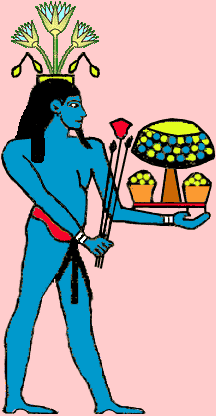
The Ancient Egyptians had no problem worshipping a mixed-gender deity. I think it is very important to draw the connection between Hapi and Antinous, especially since the First Miracle that Antinous performed as a god involved Hapi. The Egyptians accepted Antinous into their own belief system immediately and were among the most ardent followers of Antinous.
They had no problem worshipping a gay deity who had united himself with a hermaphroditic deity. It must have seemed very logical and credible to them.
It made sense to them and enriched their belief system, made it more personal since they could identify more easily with a handsome young man than with a hermaphrodite wearing a sumo belt (Hapi forgive me!).
Herodotus also said he once asked a very learned religious man in Egypt what the true source of the Nile was.
The learned man (speaking through an interpreter, since most Greeks never bothered to learn Egyptian) paused and finally told him the true source of the Nile is the thigh of Osiris.
We think of it as a strange answer. We think of the Nile as an "it" and the source as a "geographical location". But the Egyptians thought of the Nile as "us" and its true source as "heka" the magical semen of the creator.
So a learned Egyptian would have assumed that a learned Greek would understand what was meant: That Hapi is the equivalent of Dionysus, who was "incubated" in the inner thigh of Zeus after his pregnant mortal mother Semele perished when she could not bear the searing sight of her lover Zeus in all his divine panoply.
It's a very poetic way (a very Egyptian way) of saying that the "true source" of the Nile, which is to say Egypt itself, is the magical heka/semen from the loins of the original creator.
We will never know what happened during that journey up the Nile along the drought-parched fields with anxious Egyptian farmers looking to Hadrian for a miracle. All we know is that Antinous "plunged into the Nile" and into the arms of Hapi in late October of the year 130.
And then the following summer, Hapi the Inundation Deity provided a bountiful Nile flood which replenished the food stocks of Egypt and the Roman Empire.
Our own Arch Priest Antonyus Subia explains the more esoteric aspects of this special Religious Holy Day:

"The Dog Star Sirius appears, and the sacred Star of Antinous begins to approach its zenith in the night sky of the northern hemisphere. The appearance of the Dog Star once announced the rise of the Inundation of the Nile, though it no longer does due to the precession of the Equinox, which is the slight alteration of the position of the stars.
"After the Death and Deification of Antinous, the Nile responded by rising miraculously after two successive years of severe drought. It was on this day, July 25th, in the year 131 that the ancient Egyptians recognized that Antinous was a god, nine months after his death, following their custom of deifying those who drowned in the Nile, whose sacrifice insured the life-giving flood.
"Sirius is the brightest star in the sky, it is part of the constellation Canis Major, or the big dog, which is the hunting dog of Orion. Mystically, Sirius and the constellation Canis Major is Antinous Master of Hounds and Orion is Hadrian the Hunter.
"The position of Orion, along the banks of the Milky Way, our galaxy in relation to Sirius is a mirror image of Pyramids along the bank of the Nile, which is the same relationship as Antinoopolis to the Nile, with the Via Hadriani, the road which Hadrian built across the desert to the East, linking the Nile with the Red Sea Rome to India.
"We consecrate the beginning of the Dog Days of Summer to the advent of the Egyptian deification of Antinous and the miracle of the Inundation of the Nile."

The First Miracle of Antinous the Gay God is enshrined in the hieroglyphic inscription on the OBELISK OF ANTINOUS which stands in Rome
The East Face of the Obelisk, which is aligned to the rising sun Ra-Herakhte, speaks of the joy that fills the heart of Antinous since having been summoned to meet his heavenly father Ra-Herakhte and to become a god himself.
Then the inscription tells how Antinous intercedes with Ra-Herakhte to shower blessings upon Hadrian and the Empress Sabina Augusta.
And Antinous immediately calls upon Hapi ...
Hapi, progenitor of the gods,
On behalf of Hadrian and Sabina,
Arrange the inundation in fortuitous time
To make fertile and bountiful, the fields
Of Both Upper and Lower Egypt!
We joyfully celebrate this, the First Miracle of Antinous!
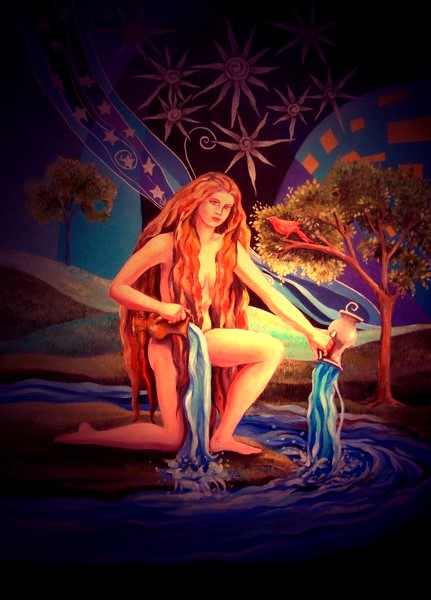
On July 11th each year, the Religion of Antinous takes a moment to ponder the esoteric reflections in the Well of Castalia at Delphi. If you have ever flicked through the Tarot cards and have been mystified by the symbolism of The Star one of the mythically most mysteriously obscure cards in the whole pack then you will be gratified to know that the symbolism has been a source of ineffible mystery since ancient times (Tarot image left).
The Well of Castalia is a fresh-water spring that flows from Mount Parnassus at Dephi, the sanctuary of Apollo. The Castalian Spring is located about 500 yards/meters from the Apollo Sanctuary itself. Busloads of tourists are whisked through the ruins of Delphi, but few ever stray away from their groups to wander off over to the spring site, which makes it an even more secluded and magical and mysterious place. It really is like stepping into the scene pictured on the Tarot card at left.
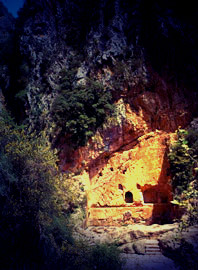
Today you can still see a rectangular square basin of about 9x3 meters/yards, hewn out in the hard soil. Next to it is a long reservoir which was fed by a small waterfall of spring water which gushed from two rocks known as the Pheriads. The reservoir collected the water before it was fed to seven jets, which had the shape of lion heads. The water was also used to sprinkle the temple of Apollo.
The spring was created when Pegasus, the winged horse, struck his hoof against a rock at the base of Mount Parnassus and water gushed forth, creating a wellspring of divine inspiration for the gods of Olympus.
The name Castalia is derived from a Nymph named Castalia, a daughter of the river Achelous, who, when pursued by Apollo, threw herself in the spring that took her name. It was the most holy spring at Delphi and was said to be the place where Apollo and the Muses bathed.

It was also believed that the God Apollo had once chased the nymph Daphne into the Tempe Canyon, which is the dramatically steep rift between Olympus and Ossa which forms a natural pass between Macedonia and Greece.
But as in mortal dreams, when he was just about to seize her, she transformed herself into a form which defied his amorous desires a laurel which Apollo then transplanted from this canyon to the Castalian Spring at the foot of Mount Parnassus.
The sacred tradition of wearing laurel wreaths comes from the tree at the foot of Mount Parnassus. There may indeed have been an ancient cult for a laurel-like tree at the spring. There appears to have been a statue for Ge, Mother Earth, as well.
In other words, it was an incredibly sacred place where you could tap into the magical inspiration of the divine muses of Olympus. After all, Apollo himself bathed here.
Pilgrims washed in the sacred water before visiting the Pythoness at the Delphic Oracle. According to Euripides, washing one's hair was sufficient for the average visitor, but persons who had transgressed more seriously against the Gods (he mentions habitual murderers as an example) had to strip off and wash themselves completely in the purifying waters.

The ancients believed the name Pegasus came from an even more ancient word meaning "wellspring of magical inspiration" and it was said that Pegasus was drinking from the Castalian Pool when Bellerophontes (or in later versions Perseus) sneaked up on him to harness Pegasus to do battle against fearful monsters.
In the Delphic Mystery Teachings, the initiates were called upon to harness the magical inspiration of Pegasus for their own indomitable quest against the inner-demons of darkness towards spiritual enlightenment.
It was also said that the water of Castalia possessed the gift of prophecy, and any man who drank there would derive prophetic vision. Castalia is also a metaphor for the Well of Knowledge, and was said to be the fountain from which wisdom and learning poured from the heart of Apollo.
We know that Hadrian and Antinous visited this spot and it seems certain that Antinous purified himself in these waters or at least washed his luxuriant hair.
An exquisite statue of Antinous was discovered at Delphi. The forearms had been broken off, but the ancient priests had lovingly buried the statue standing upright which was the way it was found in the 19th Century, incredibly intact except for the missing forearms.
Alas, Antinous would drown in the similarly magical waters of the River Nile only a few scant months after visiting Delphi, during what we call the imperial "Three-Year Peregrination" the wondrous and fateful final three-year Eastern Empire travels of Hadrian and Antinous.
Arch Priest Antonyus Subia explains why this special day, July 11th, is venerated by us Antinoians:
"We venerate the wisdom-gushing Well of Castalia on this day, half a year distant from the Well of Juturna, and bathe in preparation for the transition of the Peregrination year. We pray to Castalia to sweeten our tongue, as Antinous once bathed there, exposing the pure beauty of his flesh to the cold, fresh-gushing pool that imparts inspiration of the mind. In reverence of the wisdom and poetic elegance of Antinous, we bathe in our own Fountains of Castalia."
The imagery of this purifying plunge into the magically inspiring waters of the Castalian Well has been used throughout history even adorning the walls of early Christian churches, as seen in the mosaic (at right) found in Libya.
The imagery lives vibrantly in the XVIIth Greater Trump in the Tarot as The Star.
Right now, ANTINOUS THE MOON GOD is speeding toward the SOLAR ECLIPSE OF THE CENTURY on July 22, 2009, which will be the LONGEST ECLIPSE OF THE SUN IN THE 21st CENTURY. This eclipse will occur when ANTINOUS THE MOON GOD merges as one with his heavenly father Ra-Herakhte in the emotionally intuitive, watery depths of the Sign of Cancer. This is The Beauteous Boy's way of inviting you to lift your Inner Eye towards the STAR OF ANTINOUS and open your Mind to the Infinite.
Open your Mind and your Heart to the Mystery Teachings of Delphi. Permit yourself to be carried aloft upon the magical wings of Pegasus, whose name means "wellspring of magical inspiration". Become one with Antinous through the wonder of HOMOTHEOSIS and allow yourself to conquer your demons and to soar to glory amongst the stars.
And if, for some obscure reason, you are fool enough never to have acquired this DVD (below) and to have played it back on Stereo Dolby Digital speakers which somewhow failed to blow out the windows of your downstairs neighours, then you are a very much greater fool than I ever could have taken you to be!

On July 8th and 9th the Religion of Antinous commemorates the Ascension and Consecration of Hadrian. And on July 10th we commemorate his death and Apotheosis.
Hadrian was declared Emperor by the Legions when Trajan died suddenly while campaigning in Parthia on August 8th, 117. Hadrian had been on tenterhooks for years wondering whether Trajan would formally adopt him as his heir. If Trajan died without the issue of succession being settled, it could result in civil war or at least in the assassination of Hadrian by some other ambitious man.
It is said that the Divine Empress Plotina forged the will of her husband and gave the throne to Hadrian, who had been her protιgι and friend for years.
After assuming power, Hadrian first settled the conflict with the Persian King, signing a peace treaty that was to last through the whole of his reign. As Trajan's military representative in the provinces, he had seen how the empire was beginning to over-reach its resources. So he set about consolidating things in the East.
It is also said that he wanted to let the political dust settle back in Rome before returning to a city where his critics were waiting.
Settling other matters in the East, Hadrian waited a full year before returning to Rome, and on July 9th, 118, he entered the Holy City and was formally and ritually installed as Emperor by the Senate. He was then consecrated as Pontifex Maximus, highest priest of the Roman Religion, and head of all foreign cults.
He inherited from the warrior-king Trajan the largest empire that the western world had ever known, Rome at her greatest size and strength, and he wisely chose not to continue to expand the frontiers, but to turn instead to the development of the interior.
He visited every province, traveling more than any other emperor before or after, dedicating his power to art, literature, legal reform and the promotion of peace, prosperity, and the united religious consciousness of Roman citizenship after his beloved Athenian model.
Arch Priest Antonyus Subia says the following about this Sacred Day in our Liturgical Calendar:

"On this day, Imperator Caesar Traianus Hadrianus Augustus was to assume responsibility as the spiritual leader of the Empire, Father of the Country with a vigor unparalleled by his predecessors, and was to be one of the foremost builders of cities, temples, and public structures world-wide. For his love of Antinous and the extraordinary gesture of deifying our god, we worship and venerate Hadrian as the founder of our faith and as our immortal father, the lover of Antinous."
On July 10th the Religion of Antinous commemorates the Apotheosis of Hadrian. After a prolonged illness, at Baiae, on the Bay of Naples, Hadrian died on July 10, 138. His ashes were placed in the mausoleum on the bank of the Tibur that is now called Castelo San Angelo.
After the death of the gentle Antinous, Hadrian became embittered and cruel. When Hadrian died, the Senate wished to condemn his memory for atrocities committed against them during his final years. But his successor, Antoninus Pius, persuaded them to declare Hadrian a God. A temple was build for him known as the Hadrianeum on the Campus Marius, the remains of which are now part of the Roman Stock Exchange.
Arch Priest Antonyus Subia explains:
"Hadrian the God is venerated as the manifestation of Jupiter Optimus Maximus on Earth, the ruler and guiding force behind the Antonine Dynasty, the most sacred family of emperors, whose reign is the Golden Age of Rome, because of the peace and prosperity that it maintained, which was the result of the wisdom of Hadrian's far-sighted and divine plan stretching out over the world. We worship and adore Hadrian the God, Savior of the Cosmos."

This is the day the Liturgical Calendar of the Religion of Antinous sets aside for remembrance of that sultry summer evening in Greenwich Village in the summer of 1969 when a bunch of drag queens and assorted other gay men decided they weren't in the mood to put up with yet another raid by the corrupt and brutal NYPD.
Gays had had enough and they had just suffered a terrible shock Judy Garland's tragic death on June 22 had rocked the gay world. It was said that 13 twisters raged through Kansas the day Judy died, which in Kansas in June is a pretty safe bet, in any case. But still, and all the same ....
I remember working as a teenage cub reporter at a newspaper in conservative West Texas. When the news came over the teletype machines, a gay reporter took the story printout and a grainy wire photo of Judy and set up a little altar on his desk. He said, "I don't give a fuck who sees this. Let 'em fire me! Our Judy is dead!"
Judy had died in London, and amid much news media hype, her body was flown back to New York for a memorial service which drew a huge crowd of grief-stricken gay men who gathered outside Campbell's Funeral Chapel in Manhattan on June 27, 1969.
Afterwards, the bars were jammed with gay men drowning their sorrows in booze and drugs while listening to Judy Garland songs full blast on every jukebox.
The mood was electrified by a sense of solidarity in grieving for a fallen idol. Gay men had surprised themselves by turning out en masse for Judy's funeral. They had experienced strength in numbers for the first time. They had been on national TV news.
In an unprecedented move by prime-time national news anchormen, Walter Cronkite and Huntley-Brinkley had talked about Judy Garland's "tremendous appeal among male homosexual fans" at supper time when whole families were watching the evening news!
Blacks were standing up for their rights. Women were burning their bras. The Chicano Movement was gathering steam. And now "ho-mo-sexuals" (the announcers were unaccustomed to speaking the word aloud) were having the audacity to congregate outside a sacred chapel in broad daylight and they even showed their faces on the evening news!

Straight people were being confronted with homosexuals right there on television beamed into their homes. And more importantly homosexuals were seeing themselves and their brothers/sisters on national television news. Gays in isolated places who had worshipped Judy Garland at the movies or on LP and tape, were now watching other gay people weeping for her in New York. For the first time, gay people in isolated places saw themselves on TV. We were not alone in our grief at the passing of a star with whom we somehow innately felt connected.
It was a Friday night. Late June. Hot and steamy. The bars were filled to bursting. Gay men were sharing a rare moment of solidarity in powerful emotions. There was a feeling, not only in New York, but around the world, that a paradigm shift had taken place. A gay icon had died suddenly and tragically (shades of Antinous) and we gay people everywhere found ourselves in a catharsis of identity change. None of us understood what was happening. Just as it was with being gay, we gay men couldn't explain it, we just "felt" it and "knew" it to be true.
And THAT moment was when the Manhattan police happened to stage one of their periodic raids on queers. Basically it was a routine raid on an average gay bar. Nobody had reckoned with what would happen next. Even gay men were surprised by what happened next.
ESPECIALLY gay men.
We were men who had been accustomed to being timid fraidy-cats. Men who had never dared to stand up for their sexuality. Drag queens and faggots never fought back. That was a fact of gay survival. We knew we were gay. And we knew what we weren't. We were not "MEN".
Grief turned to outrage. It was a spontaneous uprising fuelled by rage. The vice squad was overwhelmed. Reinforcements had to be sent in. Gay men stood their ground and advanced on the police, pushing them back.
It was the turning point for us. Gay men throughout America and later in London, Berlin, Sydney and elsewhere began standing up for themselves under the banner "Remember Stonewall".
In a sense, Judy Garland died for us. Had it not been for her tragic death strangling on vomit over a toilet bowl in a London hotel suite there might not have been any Stonewall Riots.
Arch Priest Antonyus Subia puts the Stonewall Riots into a spiritual context:
"It was the first resistance by homosexuals against the repression of two thousand years, and the beginning of the Gay Liberation movement. The importance of the Stonewall Riots is the awakening of gay consciousness, the throwing off of the coils of the python that had for so many centuries enveloped our divine form of Love. This sacred revolt is holy to Apollo, Dionysus, and Diana combined as the guardian spirits of Homosexuality. Our modern Gay society was born on this occasion, and all of the peace and freedom that we have obtained in the these short decades are due to the courage that erupted on that Sacred Night in front of the Stonewall Bar."
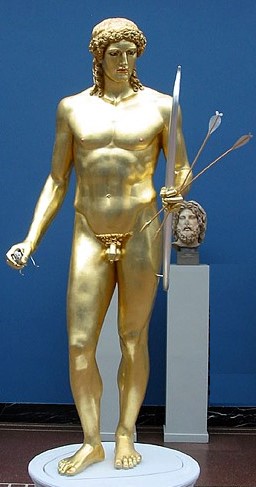
The June Solstice is one of the most sacred days in the Liturgical Calendar of the Religion of Antinous. It is the day when Ra Herakhte, the heavenly father of Antinous, stands still for a moment. In the Northern Hemisphere it is the Longest Day and from now on the days become shorter and shorter. For our brothers in the Southern Hemisphere, this is the Shortest Day and from now on the days become longer and longer.
That is an important aspect to remember about the Religion of Antinous. The Blessed Boy is beyond such constraints as Summer and Winter or even Life and Death. For Antinous, the days are ALWAYS getting longer and the they are ALWAYS getting shorter.
For HE lives in our hearts wherever we are.
Not only is it perhaps winter or perhaps summer where you live but also, depending on where you live on this blue marble in space, the Solstice occurs Saturday evening (10:48 p.m. California time) or shortly after dawn Sunday morning (6:48 a.m. in the UK) or after sunset Sunday evening (5:48 p.m. in Sydney where this is the shortest winter day).
It's all the same moment in the twinkling festively-decorated eyes of Antinous, who hovers in our spiritual hearts beyond time and space. But our earthly clocks and calendars show different times and dates and seasons. All moments in time are NOW for Antinous. All points in space are HERE.
The Religion of Antinous celebrates a whole cluster of Sacred Events on this magical day, which we call The Delphinea as a collective term. The Delphinea is the celebration of the beautiful, golden-haired god of light, Apollo, for starters.
And then we celebrate the day that Hadrian and Antinous met and fell in love. But on this date we also celebrate the beautiful boy Hyacinthus.
And we celebrate June 21st as the day in the hot summer of the year 130 AD when the Imperial entourage crossed the Sinai desert and entered into Egypt on the final, fateful leg of that final, fateful journey. A year earlier, on this date, they had entered Ephesus in triumph. On June 21st of the year 130 AD, however, they were entering a drought-stricken Egypt (breadbasket of the empire) where the local populace looked to their emperor for a miracle.

That miracle would occur, but at a terrible price. Antinous would plunge into the Nile and drown. The following season, the Nile would inundate the croplands, bringing bounty and abundance once more to Egypt and, as a consequence, to the hungry empire.
The Bountiful Flood of the year 131 is the first of the many miracles attributed to Antinous the Gay God.
And on June 21st of the year 131, Hadrian would commission the OBELISK OF ANTINOUS, the Egyptian hieroglyphic text of which comprises our religion's greatest single document of faith.
But first, back to Apollo and the Solstice! Antinous would be associated with many deities in the generations to come. Among his many names, the Beauteous Boy was adored as Antinous-Apollo.
The glorious image above left shows a modern reproduction of the Apollon Parnopios which has been gilded and fitted with gemstone eyes to show how it might have looked in a temple where a ray of sunlight would have set it ablaze in gleaming light.
The Delphinea is the celebration of the beautiful, golden-haired god of light, Apollo, and of his triumph over the great and monstrous Python which was wrapped around holy mount Parnassus. The Python was the creation of Juno, a creature of jealousy whose coils were meant only to stifle and constrict the grace of that which was to proceed from the Sacred Way of the holy city of Delphi.
Apollo shot the Python and destroyed it, when he was only three days old, which is like the brilliance of the Sun dispelling the covering of night. He set the black stone which had fallen from the sky, called the Omphalos, over the navel of the Earth, and charged a Sibyl, a priestess of the Great Mother to watch over the stone and to convey his wisdom to mankind.
Arch Priest Antonyus Subia explains the significance for us Antinoians:
"The Oracle of Delphi, called a Pythoness, was overtaken while seated atop a golden tripod, by a fire that is the breath of the God. Apollo is the Flower Prince reborn, he is the Twin brother of Dionysus, the Twin brother of Diana. He is the Son of Zeus, and the inheritor of his Kingdom, just as Aelius Caesar was the chosen son of Hadrian."Apollo is the God of wisdom and art, the speaker of truth, the deliverer of radiance, reason and beauty. Apollo is the God of Socrates and Plato, and he is the God of Pythagoras who claimed to be his son, exhibiting a golden thigh as proof. Apollo is the unconquered light, the full manifested brilliance, power and wisdom of Orpheus.
"Of all the gods, Apollo is the most boy-loving, though the touch of his heart was invariably fatal. He is the genius of the dying boy-gods. We pray to Apollo, the great god of homosexuality, and seek his guidance on this day, the longest day of the year."

Which segues into the "Incipit Amor". In the year 123, Hadrian toured the Danube region and Asia Minor. It was on this occasion that he met and fell in love with Antinous, in the ancient Bithynian capital city of Nicomedia, according to current research. One portrayal of the event has Hadrian in a garden, surrounded by the youth of the city, hearing a poetry recital.
Antonyus tells it this way:
"Towards the back of the crowd, Hadrian notices a boy of extraordinary beauty who did not bring a stylus and tablet for taking notes, but sat removed from the others, silently gazing into the fountain, contemplating the words of the reader, as if in a dream. Hadrian was captivated, and is said to have gained the blessing of the boy's parents to have Antinous join the court, where there were already other boys of Hadrian's interest. Antinous would have been twelve years old. He was then sent to Rome to attend the Paedagogium, a finishing school for boys. This day marks the beginning of the love upon which our religion is based."
The relief sculpture at right shows Hadrian addressing a crowd with a boy who bears a striking resemblance to Antinous foremost in the crowd, touching the robe of the Emperor.
And speaking of beautiful boys, on June 22nd we honor the beautiful boy from Sparta known as Hyacinthus. It is highly fitting that this year the Feast Day of Hyacinthus on June 22nd coincides with the Cancer New Moon, which is the most romantic New Moon Cycle of the year, and the reason why June is the favored month in which to marry.
The astonishing beauty of Hyacinthus and his long, flowing blonde hair was first noticed by Zephyrus, the God of the West Wind. The moisture laden Zephyrus fell madly in love with the boy, and attempted many times to seduce Hyacinth. But every time the boy rejected the wind god, whose breeze is the most lovely and most arousing.
Antonyus relates what happened next:

"It was then that Apollo noticed Hyacinthus and fell completely in love with him also. Unlike with Zephyrus, when Apollo revealed his love to Hyacinthus, he was not rejected, but his shining love was returned many fold. The two, who were like twins, whose long, blonde curls, rustled together in the jealous wind of Zephyrus, enjoined a passionate love affair ...
"... until one day, the sight of their happiness proved too much for Zephyrus to endure, and while Apollo and Hyacinthus were throwing the discus together, the wind god sent a gust of air, when Apollo threw the golden disk, causing it to fall directly on the perfect head of Hyacinthus who died instantly from the blow.
"It was all an accident, and a tragedy, but Apollo was beside himself with grief, like Hadrian holding the body of his beloved Antinous.
"The Sun God turned the blood that flowed through the soft curls into the flower that we call the Hyacinth. The Death of Hyacinthus is the divine metaphor for the beauty and tragedy of life taken from the young in their full vigor, falling victim to the accidents of youth. It is also a warning to those who would approach the majesty of the great god Apollo, who is rightfully called the Far-Shooter, and the falling of the golden discus is a sign that the powers of the sun at this time of the year, though at their greatest, are slowly fading. The disk strikes Hyacinth on the head and the days grow shorter."
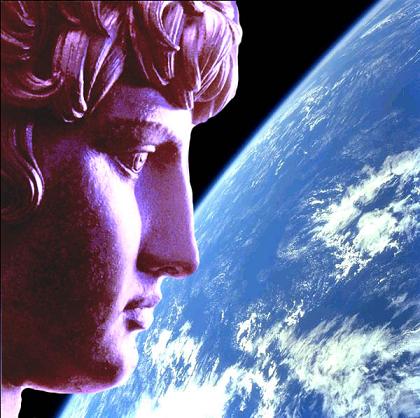
On June 11, the Religion of Antinous celebrates the Rise of the Star of Antinous. This is the date in our Liturgical Calendar when the Constellation of Antinous begins to rise over the horizon at sunset. It is visible on the eastern horizon along the banks of the Milky Way.
The most visible identifiers are the three bright stars of Aquila Altair at the crown of his head, Tarazad, and Alshain. Alshain is derived from Arabic for "Two Friends" which astrologers have cited as a hint as to how to interpret the Sign of Antinous.
Wherever you live on this blue marble we call Earth, you can see the Constellation of Antinous on starry nights from mid-June through late October when, in synchronicity with the Death of Antinous in late October, the Star of Antinous descends below the western horizon in the glare of the setting sun.
The Constellation of Antinous is no longer recognized by astronomers (just as Pluto has been demoted to the rank of "dwarf planet"). But it is still visible from any point on Earth nestled between Sagittarius and Capricorn and in the talons of Aquila (the Eagle Constellation) representing the Imperial Eagle which carried Antinous to lofty heights.
The Star of Antinous is however difficult to see. Most people cannot see it at all. You won't find it on any star chart. Like the Star of Bethlehem, it is a mystery and a conundrum about which many theories have been written.
The simple truth of the matter and the most beautiful facet of all is the fact that Hadrian discovered the Star of Antinous with his own tear-filled eyes as he looked skyward in grief after the death of his beloved Antinous. Distraught and weeping, the emperor stood under the canopy of the star-studded heavens and looked up the River Nile towards the spot where his Beloved Boy had died. And he saw a new star which he recognized as a celestial sign that the gods had taken Antinous to be one of them.

You have to realize that Hadrian was a keen astronomer/astrologer himself. He knew the heavens like the back of his hand and he was so adept at casting horoscopes that it was said he had determined the exact hour of his death. He built an observatory at his sumptious villa outside Rome. And the tour of Egypt had brought him into contact with the finest Egyptian magician/priests, one of whom taught him how to cast a binding spell which could give him dream-visions and could also cause someone to fall hopelessly in love with him or depending on how it was cast even cause that person to die in agony.
Hadrian was that sort of control freak. Despite the fact that he was the mightiest man on Earth who could send a man to death on a whim (and did so, on occasion), he also wanted control over the future. And he wanted to be able to force someone to love him and never, never leave him.
Much has been theorized about that magical spell, which was sold to Hadrian for a princely sum by the Heliopolis magician/priest Pancrates, who even demonstrated its efficacy by destroying a man right in front of the emperor's eyes. This is believed to be the same Pancrates who wrote a poem about Hadrian and Antinous and The Sacred Lion Hunt, during which Antinous very nearly died, but was saved at the last second by Hadrian.
Yes, much has been written about these events and about Hadrian's obsession with magic and astrology and soothsayers. Why would the most powerful man in the world need a death spell? Whose love would he possibly seek to bind to himself for all eternity? We know that similar love spells were a specialty of the later magician/priests at the Great Temple of Antinoopolis founded on the site where the Boy drowned.

Had the ageing emperor attempted to cast a love spell which tragically backfired and resulted in the death of the spell's intended subject? We shall never know ....
Whatever transpired, Antinous died under circumstances which were as mysterious as they were tragic. And Hadrian was consumed with grief which traumatized him to such a degree that the rest of his reign was marked by erratic judgement and unpredictable outbursts of rage.
Up until the year 130 his reign had been marked by peace and prosperity and humanity. Hadrian was well on his way towards fulfilling his dream of transforming the Roman Empire from a collection of provinces held together only by military force into a very modern-style, multi-culti society united by shared cultural and social values of tolerance and fairness. He was aiming for a kind of cultural globalism. And he was very close to succeeding ....
But after the traumatic events in October 130, the last eight years of his reign were marred by an ill-advised war against the Jews and by capricious cruelty which sullied his reputation for all time.
After Antinous died, Hadrian went slightly mad with grief.
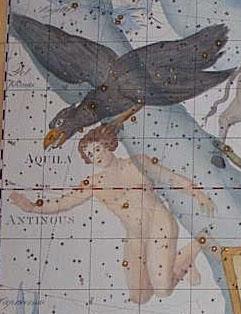
Something in Hadrian died when Antinous died. A light went out. Hadrian spent the rest of his life seeking that Light of Antinous. He created the Religion of Antinous after his own romantic vision of the ideal religion. Like many romantic gay men, Hadrian idealized an era and a society Classical Greece to such a degree that his fantasy Classical Greece was far grander than the real thing had ever been. You all know what I mean. We've all seen gay men who collect Victoriana and who turn their homes into lavish 19th Century mansions quite forgetting the fact that the Victorian Age was marked by repression, disease, exploitation, colonial tyranny and so on.
The Portuguese have a word for this: "saudade". It is an untranslatable word for a melancholy feeling of wistful longing for something (or someone) which was too wonderful, too fantastic, too perfect ever to have really existed.
Hadrian spent his life in search of spiritual enlightenment, having himself initiated into the Mysteries of Eleusis and Dionysus and other cults and also conferring with philosophers and magician/priests.
Hadrian was obsessed with astrology/astronomy and magic and a highly idealized vision of recreating Hellenistic cultural values in the world and with a religion which would enable everyone in the world to bring this vision to life in their own hearts. He wanted to find that Light of Antinous (his idealized religion of love and beauty) and he wanted everyone to find that Light of Antinous.

Saudade the quest for something so beautiful, so romantic, so splendid that it defies physical reality and can exist only in the perfect realm of the place the Egyptians called Sep Tepy (the "Initial Moment" of Creation) or the Classical Greeks called Olympus the realm of the immortal gods, beyond time and space.
So Hadrian looked into the nighttime skies and discovered a new star to point the way to that new religion. As a scholar and man of science he was able to see it with his own two eyes. Perhaps it was a super-nova which flared and then went out who knows? He saw it and his court astronomers confirmed it and the Constellation of Antinous was recorded in the star charts for 19 centuries to come.
But more importantly, Hadrian discovered the Star of Antinous shining in his heart. The Death of Antinous showed him a way to make his saudade vision of the perfect religion a reality on Earth. It was the Light he was seeking. It was the Light of Antinous.
So when you look up into the nighttime skies tonight in search of the Star of Antinous, don't be surprised if you can't find it with your physical eyes. You can't find it in physical space, which is why Arch Priest Antonyus Subia calls it the Dark Star of Antinous. Look inside your heart and you will find it shining there with all the saudade beauty of a dream of perfection.
Lumen Antinoi Adiuva Nos! (Light of Antinous, Sustain Us!)
SEPTEMBER through DECEMBER 2009

ALL RIGHTS RESERVED
PERMISSION MUST BE GRANTED BY THE AUTHOR FOR USE ELSEWHERE